#30 Under 30 Asia
Explore tagged Tumblr posts
Text
Trò chuyện với nam sinh Việt trẻ nhất trong lịch sử được Forbes vinh danh ‘30 Under 30 Asia’: Mơ người trẻ Việt có thể thay đổi thế giới như Mark Zuckerberg, Bill Gates
Sau khi hoàn thành năm nhất tại Đại học Carleton College ở Mỹ, Trần Tuấn Minh (Brian Minh Tran) quyết định trở về Việt Nam, cùng cộng sự cùng thành lập và phát triển UpYouth hỗ trợ sinh viên khởi nghiệp tại Việt Nam. Bên cạnh những đóng góp tại UpYouth, Trần Tuấn Minh còn từng giữ vị trí trợ lý cho PTGĐ Thường Trực Toàn Cầu của VinFast. Tuấn Minh luôn nung nấu một khát vọng sẽ đưa sản phẩm Việt…

View On WordPress
#30 Under 30 Asia#Gương mặt trẻ được Forbes vinh danh#Tài năng trẻ Việt Nam#UpYouth hỗ trợ khởi nghiệp
0 notes
Text
Yes I have over 100 tabs open, no I cannot close them that's my emotional support Wikipedia page for Timor-Leste
#did you know that Timor-Leste is one of the most isolated countries in the world#and as of 2017 less than 30% of the population had internet access?#it also ranks 10th in world press freedom and is considered one of the most free and fair democracies in Asia#it's also very tiny with a population of under 1.5 million
15 notes
·
View notes
Text
I hate being on twitter for competitive splatoon because this shitass social media keeps showing me the most braindead takes such as “public health measures during the Black Death were better than the Covid-19 pandemic”
#it’s time for me to be a history major#purely looking at the stats:#okay. yeah the disease that wiped out an estimated 1/3-2/3 of the European population had better public health measures than now#THE MOST DEADLY PANDEMIC IN HUMAN HISTORY#minimum 75 MILLION death toll#estimated to get up to TWO HUNDRED MILLION#COVID’s current death toll according to WHO is just under 7 million#WHAT ARE YOU FUCKING TALKING ABOUT#I HAVENT EVEN MENTIONED THAT THE ‘PUBLIC HEALTH MEASURES’ THE PERSON WAS REFERENCING IS BLOODLETTING SELF-FLAGELLATION AND WALLING CITIES#MEDICINE WAS NOT THAT GREAT IN THE FOURTEENTH CENTURY#most braindead twitter user#like the bubonic plague was HORRIFIC#it quite literally devastated europe and Asia and the Middle East like everywhere#and had quite far reaching impacts#like take a second to think about it#just in Europe 30-60% of the population dies#that is traumatizing dude#just like#HOW CAN YOU THINK LIKE THIS TWITTER USER
8 notes
·
View notes
Text
#Atithi Devo Bhava#Forbes 30 Under 30 Asia#Hotel News#Hotels and Resorts#Icons of India#Indian polo player#Maharaja Sawai Padmanabh Singh#The Leela Palaces
0 notes
Video
youtube
What Is The Size Of Is Africa? 😀 #shorts #youtubeshorts
#youtube#What Is The Size Of Is Africa? 😀 shorts youtubeshorts africa continent asia Africa’s true size is 30 million square km just under twice th
0 notes
Link
Forbes announced today its eighth annual “30 Under 30 Asia” list, featuring 300 young entrepreneurs, leaders and trailblazers across the Asia-Pacific region.
0 notes
Text
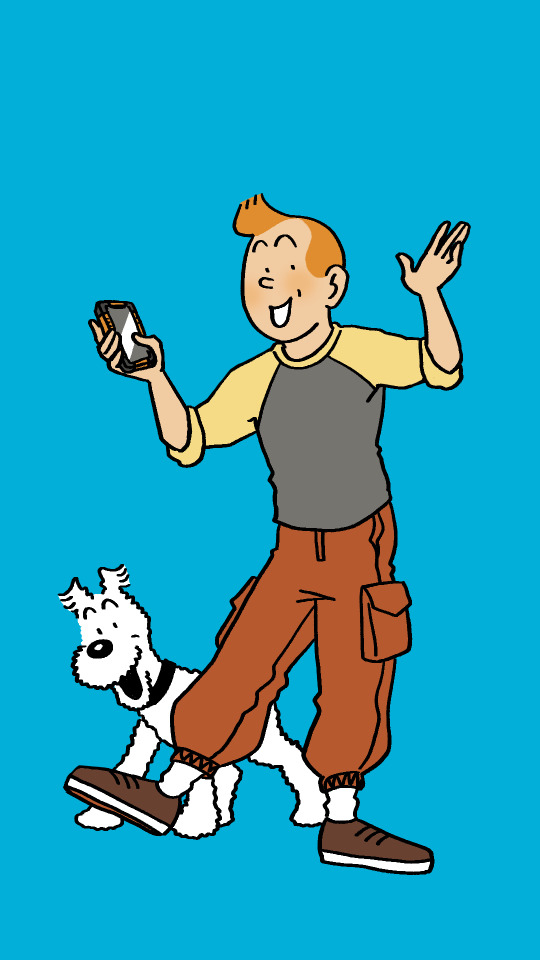

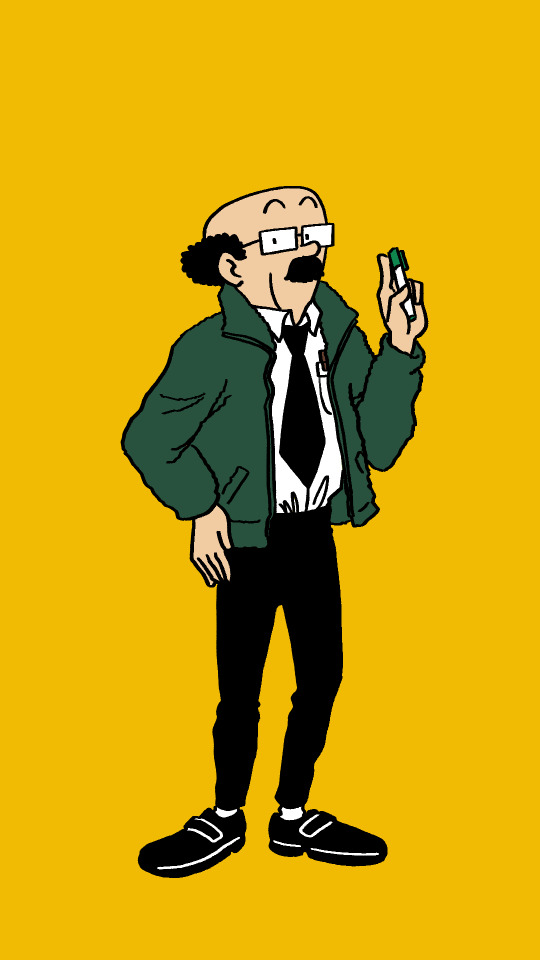
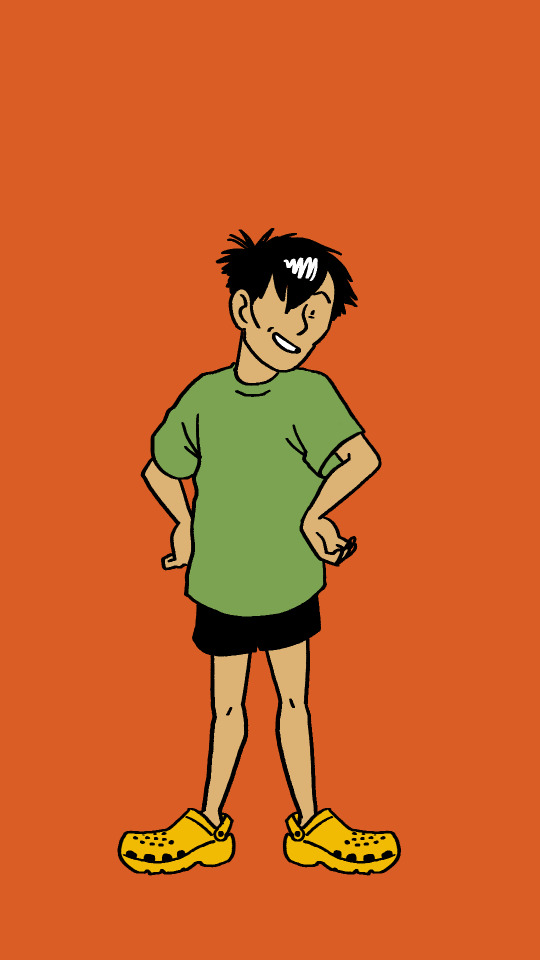


Modern AU versions of Tintin and his friends! Notes about their designs under the Read More:
Tintin - A grey and yellow baseball tshirt references his grey sweatervest and yellow shirt look from the earlier comics. Cargo joggers replace his plus fours - plus fours were popular with golfers in the 20s and 30s as athletic wear, so I opted for cargo joggers for that preppy but sporty vibe. He also wears leather trainers and keeps his handy phone in an industrial case. Snowy wears a collar now!
Haddock - when not working on a ship as a merchant captain he opts for a hoodie and sweatpants. He might look sloppy but it's pretty practical for the wild adventures he's dragged into! He's Tintin's exhausted foster father in this AU.
Calculus - I gave him 2000s style rectangular frames to make him feel modern but still kind of dated, like how he wears fashion a few decades behind in the canon comics. I dressed him like my high school physics teachers - he has a necktie, a pocket protector, a zip through fleece and orthopedic shoes. I had frames like these for some time until I broke them at work lol
Chang - as soon as I read the Blue Lotus and saw Chang for the first time I immediately thought he was wearing crocs. I don't know why crocs are so popular. I don't think they're particularly comfortable. They feel sweaty and weird and don't stay on your feet when you run. I don't get crocs. But they're popular in Asia lol (I kept Chang's design super simple, he's an orphan with no money)
Abdullah - I had way too much fun with him! I know Supreme is kinda dated now (it's definitely a 2016 thing) but I still find it funny and the colour scheme fits. A lot of local Muslim teenagers in my area mix sportswear with traditional clothing so I did the same here, but made it obnoxiously bougie lol
Zorrino - I didn't change much for him as his original design is pretty timeless. I gave him socks and slides, a beanie and joggers. His button up shirt is replaced with a polo shirt but the difference isn't big.
#tintin#adventures of tintin#captain haddock#archibald haddock#professor calculus#cuthbert calculus#chang#abdullah#zorrino#fanart#modern au#photoset#snowy#milou#alcohol tw#smoking tw
2K notes
·
View notes
Text

Medieval Game Pieces Emerge From the Ruins of a German Castle
A small cache of medieval game pieces has been discovered in the ruins of a recently discovered castle in southern Germany. The finds provide a window into leisure time, possibly among actual knights, dating back nearly a millennium, approximately the time that chess arrived in Europe as an import from Asia.
The find includes a six-sided die, assorted game pieces including four in the shape of flowers, and a very well-preserved 1½-inch-high chess piece, all carved from antlers.
“In the Middle Ages, chess was one of the seven skills that a good knight should master,” said Jonathan Scheschkewitz, of the State Office for the Preservation of Monuments Baden-Württemberg. “It is therefore not surprising that known finds mostly come from castles.”
There is evidence that these are not just display objects, but pieces that were actually used. “Under the microscope,” explained Flavia Venditti of the University of Tübingen, “a typical sheen from holding and moving the pieces can be seen.”

An international team of experts from the University of Tübingen, the State Office for the Preservation of Monuments Baden-Württemberg and the German Archaeological Institute is now examining this evidence of early gaming culture.
“The discovery of an entire games collection [from] the 11th/12th century came as a complete surprise to us,” said Lukas Werther, of the German Archaeological Institute, “and the horse-shaped knight piece is a real highlight.”
The pieces came to light during excavations by the DFG Collaborative Research Centre 1070 Resource Cultures and the State Office for the Preservation of Monuments Baden-Württemberg in a previously unknown castle in the Reutlingen district of southern Germany’s Baden-Württemberg region.


“They were lying under the debris of a wall where they were lost or hidden in the Middle Ages,” said Michael Kienzle of the University of Tübingen. They are in such good condition, he added, precisely because they had been covered under those materials.
They will go on display this month in two exhibitions: “Excavated! Knights and Castles in the Echaz Valley” at the Schlössle Pfullingen (June 15–August 30) and “The Hidden Länd: We in the First Millennium” at the Archaologisches Landsmuseum Baden-Württemberg (September 13, 2024–January 26, 2025).

#Medieval Game Pieces Emerge From the Ruins of a German Castle#Germany’s Baden-Württemberg region#ancient artifacts#archeology#archeolgst#history#history news#ancient history#ancient culture#ancient civilizations#middle ages#medieval history#medieval art
437 notes
·
View notes
Text
HELLO OTHERKIN/THERIANS/ALTERHUMANS/NONHUMANS/OTHERLINKERS/OTHERPAW!! DO YOU WANT TO BUY AN ETHICAL TAIL BUT DON'T KNOW WHERE? IM HERE TO GIVE YOU TIPS!
Okay I'll stop talking in caps now, but here you have my tail guide for any and all people who just want a tail!
Cruel fur farms treat their animals badly, and it's best to avoid them. Here are some tips on how to spot cruel farms from the ethically sourced ones! (Most tips from here!)
Disclaimer: I would only be wary of items if they show more than 2 of these signs. Just do research before you buy!
Signs that indicate a cruel source:
- Sold/Sourced from Asia (Asia has bad animal cruelty laws, here's a list per country on how good their animal rights are)
- From Wish, AliExpress, Amazon, Temu or EBay (Even the 'faux fur' ones can be real and cruel)
- If they use stock photos
- Asian lobster clams (This does not always indicate cruelty)
- If they look thin, small, and generally unhealthy
- Any usage of 'mink farms' in desc.
- If they are bleached or colored
- If the price is low (Under 20-25)
- No info about source (Always ask the seller if you're not sure)
Signs that indicate ethical source:
- Scraps that were being thrown away otherwise (Should be in item description or FAQ)
- Lived long and happy lives (Item description or FAQ)
- Thick, healthy tails
- Population control/Legal hunters (With a permit)
Now I'll show a few Etsy shops I've confirmed to be Ethically sourced!

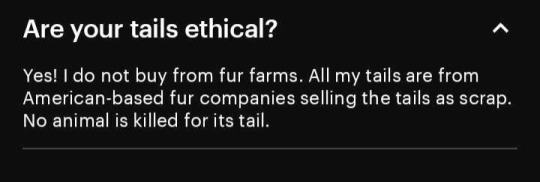
WolfBoyGirl
^ Cute animal tails with charms
Prices: €28,48 - €68,35


FoxintheForestAU
^ Coyote & Possum tails, would check each item separately to be sure :3
Prices: €11,49 - €38,30
Disclaimer! These do not come with clips, you have to add them yourselves
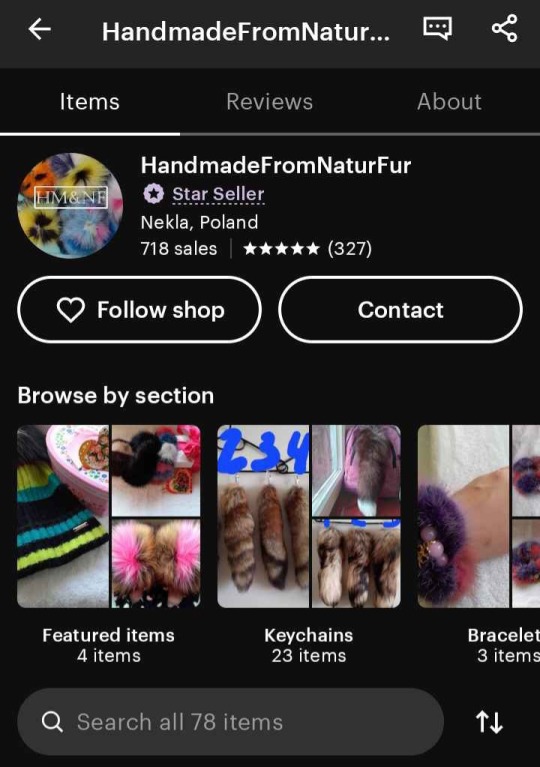
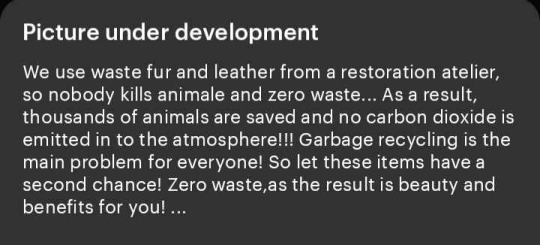
HandmadeFromNaturFur
^ Fox tails of all colors
Prices: €25,42 - €55,07


VeluwsCuriosities
^ Fox tails
Prices: €23,94


IowaFinestFurs
^ Raccoon, mink, coyote, raccoon dog/tanuki, skunk & lynx tails! (tw for a lot of animal pelts)
Prices: €8,57 - €19,98
Disclaimer! These do not come with clips, you have to add them yourselves
Etsy shops that sell faux fur tails!

scopermanstar
^ Variety faux fur tails with squeakers in them! Foxes/Canines, wild cats & nub tails!
Prices: €22,78 - €235,36 (Most are around €30-€40)

Cosearparty (Currently not selling items, sorry!) ^ Faux fur cosplay tails & ears (Mainly the bigger ones like cheetah, snow leopard, etc.)
Prices: €25,63 - €102,52 (Most are around <40 and are often tail + ears combo)
If you know any other ethical/faux fur Etsy shops, please link them and I'll add them here! :D
#tw animal pelts#< and other such items#therian#alterhuman#otherkin#therianlucub#nonhuman#therian things#therianthropy#otherpaw#otherlink#funlink#copinglink#therian tail#otherhearted#alterhumanity#foxkin#theriotype#therian gear#therianthrope#theriantropy#therian community#alterhuman gear#otherkin gear#vulture culture
276 notes
·
View notes
Text
The Real Cost of the Fashion Industry

Atacama Desert, in Alto Hospicio, Iquique, Chile. (source)
The textile industry is destroying the world. The industry is wasting massive amounts of energy and materials, and polluting the air, the ground and the water supplies. It overwhelmingly exploits it's labour and extracts wealth from colonized countries, especially in Asia. I assume we all broadly understand this, but I think it's useful to have it all laid out in front of you to see the big picture, the core issues causing this destruction and find ways how to effectively move forward.
The concerning trend behind this ever-increasing devastation are shortening of trend cycles, lowering clothing prices and massive amount of wasted products. Still in year 2000 it was common for fashion brands to have two collections per year, while now e.g. Zara produces 24 collections and H&M produces 12-16 collections per year. Clothing prices have fallen (at leas in EU) 30% from 1996 to 2018 when adjusted to inflation, which has contributed to the 40% increase in clothing consumption per person between 1996 and 2012 (in EU). (source) As the revenue made by the clothing industry keep rising - from 2017 to 2021 they doubled (source) - falling prices can only be achieved with increasing worker exploitation and decreasing quality. I think the 36% degrees times clothing are used in average during the last 15 years (source) is a clear indication on the continuing drop in quality of clothing. Clothing production doubled between 2000 and 2015, while 30% of the clothes produced per year are never sold and are often burned instead (source), presumably to prevent the returns from falling due to oversupply.
These all factors are driving people to overconsume. While people in EU keep buying more clothes, they haven't used up to 50% of the clothes in their wardrobe for over a year (source). This overconsumption is only made much worse by the new type of hyper fast fashion companies like SHEIN and Temu, which are using addictive psychological tactics developed by social media companies (source 1, source 2). They are cranking up all those concerning trends I mentioned above.
Under the cut I will go through the statistics of the most significant effects of the industry on environment and people. I will warn you it will be bleak. This is not just a fast fashion problem, basically the whole industry is engaging in destructive practices leading to this damage. Clothing is one of those things that would be actually relatively easy to make without massive environmental and human cost, so while that makes the current state of the industry even more heinous, it also means there's hope and it's possible to fix things. In the end, I will be giving some suggestions for actions we could be doing right now to unfuck this mess.
Carbon emissions
The textile industry is responsible for roughly 10% of the global CO2 emissions, more than aviation and shipping industry combined. This is due to the massive supply chains and energy intensive production methods of fabrics. Most of it can be contributed to the fashion sector since around 60% of all the textile production is clothing. Polyester, a synthetic fiber made from oil which accounts for more than half of the fibers used in the textile industry, produces double the amount of carbon emissions than cotton, accounting for very large proportions of all the emissions by the industry. (source 1, source 2)
Worker exploitation
Majority of the textiles are produced in Asia. Some of the worst working conditions are in Bangladesh, one of the most important garment producers, and Pakistan. Here's an excerpt from EU Parliament's briefing document from 2014 after the catastrophic Rana Plaza disaster:
The customers of garment producers are most often global brands looking for low prices and tight production timeframes. They also make changes to product design, product volume, and production timeframes, and place last-minute orders without accepting increased costs or adjustments to delivery dates. The stresses of such policies usually fall on factory workers.
The wage exploitation is bleak. According to the 2015 documentary The True Cost less than 2% of all garment factory workers earned a living wage (source). Hourly wages are so low and the daily quotas so high, garment workers are often forced through conditions or threats and demand to work extra hours, which regularly leads to 10-12 hour work days (source) and at worst 16 hour workdays (source), often without days off. Sometimes factories won't compensate for extra hours, breaching regulations (source).
Long working hours, repetitive work, lack of breaks and high pressure leads to increased risks of injuries and accidents. Small and even major injuries are extremely common in the industry. A study in three factories in India found that 70% of the workers suffered from musculosceletal symptoms (source). Another qualitative study of female garment workers and factory doctors in Dhaka found that long hours led to eye strain, headaches, fatigue and weight loss in addition to muscular and back pains. According to the doctors interviewed, weight loss was common because the workers work such long hours without breaks, they didn't have enough time to eat properly. (source) Another study in 8 factories in India found that minor injuries were extremely common and caused by unergonomic work stations, poor organization in the work place and lack of safety gear, guidelines and training (source). Safety precautions too are often overlooked to cut corners, which periodically leads to factory accidents, like in 2023 lack of fire exists and fire extinguishers, and goods stacked beyond capacity led to a factory fire in Pakistan which injured dozens of workers (source) or like in 2022 dangerous factory site led to one dead worker and 9 injured workers (source).
Rana Plaza collapse in 2013 is the worst industrial accident in recent history. The factory building did not have proper permits and the factory owner blatantly ignored signs of danger (other businesses abandoned the building a day before the collapse), which led to deaths of 1 134 workers and injuries to 2 500 workers. The factory had or were at the time working for orders of at least Prada, Versace, Primark, Walmart, Zara, H&M, C&A, Mango, Benetton, the Children's Place, El Corte Inglés, Joe Fresh, Carrefour, Auchan, KiK, Loblaw, Bonmarche and Matalan. None of the brands were held legally accountable for the unsafe working conditions which they profited off of. Only 9 of the brands attended a meeting to agree on compensation for the victim's families. Walmart, Carrefour, Auchan, Mango and KiK refused to sight the agreement, it was only signed by Primark, Loblaw, Bonmarche and El Corte Ingles. The compension these companies provided was laughable though. Primemark demanded DNA evidence that they are relatives of one of the victims from these struggling families who had lost their often sole breadwinner for a meager sum of 200 USD (which doesn't even count for two months of living wage in Bangladesh (source)). This obviously proved to be extremely difficult for most families even though US government agreed to donate DNA kits. This is often said to be a turning point in working conditions in the industry, at least in Bangladesh, but while there's more oversight now, as we have seen, there's clearly still massive issues. (source 1, source 2)
One last major concern of working conditions in the industry I will mention is the Xinjiang raw cotton production, which is likely produced mainly with forced labour from Uighur concentration camps, aka slave labour of a suspected genocide. 90% of China's raw cotton production comes from Xinjiang (source). China is the second largest cotton producer in the world, after India, accounting 20% of the yearly global cotton production (source).
Pollution
Synthetic dyes, which synthetic fibers require, are the main cause of water pollution caused by the textile industry, which is estimated to account for 20% of global clean water pollution (source). This water pollution by the textile industry is suspected of causing a lot of health issues like digestive issues in the short term, and allergies, dermatitis, skin inflammation, tumors and human mutations in the long term. Toxins also effect fish and aquatic bacteria. Azo dyes, one of the major pollutants, can cause detrimental effects to aquatic ecosystems by decreasing photosynthetic activity of algae. Synthetic dyes and heavy metals also cause large amounts of soil pollution. Large amounts of heavy metals in soil, which occurs around factories that don't take proper environmental procautions, can cause anaemia, kidney failure, and cortical edoem in humans. That also causes changes in soil texture, decrease in soil microbial diversity and plant health, and changes in genetic structure of organisms growing in the soil. Textile factory waste water has been used for irrigation in Turkey, where other sources of water have been lacking, causing significant damage to the soil. (source)
Rayon produced through viscose process causes significant carbon disulphide and hydrogen sulphide pollution to the environment. CS2 causes cardiovascular, psychiatric, neuropsychological, endocrinal and reproductive disorders. Abortion rates among workers and their partners exposed to CS2 are reported to be significantly higher than in control groups. Many times higher amounts of sick days are reported for workers in spinning rooms of viscose fiber factories. China and India are largest producers of CS2 pollution, accounting respectively 65.74% and 11,11% of the global pollution, since they are also the major viscose producers. Emission of CS2 has increased significantly in India from 26.8 Gg in 2001 to 78.32 Gg in 2020. (source)
Waste
The textile industry is estimated to produce around 92 million tons of textile waste per year. As said before around 30% of the production is never sold and with shortening lifespans used the amount of used clothing that goes to waster is only increasing. This waste is large burned or thrown into landfills in poor countries. (source) H&M was accused in 2017 by investigative journalists of burning up to 12 tonnes of clothes per year themselves, including usable clothing, which they denied claiming they donated clothing they couldn't sell to charity instead (source). Most of the clothing donated to charity though is burned or dumbed to landfills (source).
Most of the waste clothing from rich countries like European countries, US, Australia and Canada are shipped to Chile (source) or African countries, mostly Ghana, but also Burkina Faso and Côte d'Ivoire (source). There's major second-hand fashion industries in these places, but most of the charity clothing is dumbed to landfills, because they are in such bad condition or the quality is too poor. Burning and filling landfills with synthetic fabrics with synthetic dyes causes major air, water and soil pollution. The second-hand clothing industry also suppresses any local clothing production as donated clothing is inherently more competitive than anything else, making these places economically reliant on dumbed clothing, which is destroying their environment and health, and prevents them from creating a more sustainable economy that would befit them more locally. This is not an accident, but required part of the clothing industry. Overproduction let's these companies tap on every new trend quickly, while not letting clothing the prices in rich countries drop so low it would hurt their profits. Production is cheaper than missing a trend.
Micro- and nanoplastics
There is massive amounts of micro- and nanoplastics in all of our environment. It's in our food, drinking water, even sea salt (source). Washing synthetic textiles accounts for roughly 35% of all microplastics released to the environment. It's estimated that it has caused 14 million tonnes of microplastics to accumulate into the bottom of the ocean. (source)
Microplastics build up into the intestines of animals (including humans), and have shown to probably cause cause DNA damage and altered organism behavior in aquatic fauna. Microplastics also contain a lot of the usual pollutants from textile industry like synthetic dyes and heavy metals, which absorb in higher quantities to tissues of animals through microplastics in the intestines. Studies have shown that the adverse effect are higher the longer the microplastics stay in the organism. The effects cause major risks to aquatic biodiversity. (source) The health effects of microplastics to humans are not well known, but studies have shown that they could have adverse effects on digestive, respiratory, endocrine, reproductive and immune systems. (source)
Microplastics degrade in the environment even further to nanoplastics. Nanoplastic being even smaller are found to enter blood circulation, get inside cells and cross the blood-brain barrier. In fishes they have been found to cause neurological damage. Nanoplastics are also in the air, and humans frequently breath them in. Study in office buildings found higher concentration of nanoplastics in indoor air than outdoor air. Inside the nanoplastics are likely caused mostly by synthetic household textiles, and outdoors mostly by car tires. (source) An association between nanoplastics and mitochondrial damage in human respiratory cells was found in a recent study. (source)
Micro and nano plastics are also extremely hard to remove from the environment, making it even more important that we reduce the amount of microplastics we produce as fast as possible.
What can we do?
This is a question that deserves it's own essays and articles written about it, but I will leave you with some action points. Reading about these very bleak realities can easily lead to overwhelming apathy, but we need to channel these horrors into actions. Whatever you do, do not fall into apathy. We don't have the luxury for that, we need to act. These are industry wide problems, that simply cannot be fixed by consumerism. Do not trust any clothing companies, even those who market themselves as ethical and responsible, always assume they are lying. Most of them are, even the so called "good ones". We need legislation. We cannot allow the industry to regulate itself, they will always take the easy way out and lie to their graves. I will for sure write more in dept about what we can do, but for now here's some actions to take, both political and individual ones.
Political actions
Let's start with political actions, since they will be the much more important ones. While we are trying to dismantle capitalism and neocolonialism (the roots of these issues), here's some things that we could do right now. These will be policies that we should be doing everywhere in the world, but especially rich countries, where most of the clothing consumption is taking place. Vote, speak to others, write to your representative, write opinion pieces to your local papers, engage with democracy.
Higher requirements of transparency. Right now product transparency in clothing is laughably low. In EU only the material make up and the origin country of the final product are required to be disclosed. Everything else is up to the company. Mandatory transparency is the only way we can force any positive changes in the production. The minimum of transparency should be: origin countries of the fibers and textiles in the product itself; mandatory reports of the lifecycle emissions; mandatory reports of whole chain of production. Right now the clothing companies make their chain of production intentionally complex, so they have plausible deniability when inevitably they are caught violating environmental or worker protection laws (source). They intentionally don't want to be able to track down their production chain. Forcing them to do so anyway would make it very expensive for them to keep up this unnecessarily complex production chain. These laws are most effective when put in place in large economies like EU or US.
Restrictions on the use of synthetic fibers. Honestly I think they should be banned entirely, since the amount of microplastics in our environment is already extremely distressing and the other environmental effects of synthetic fibers are also massive, but I know there are functions for which they are not easily replaced (though I think they can be replaces in those too, but that's a subject of another post), so we should start with restrictions. I'm not sure how they should be specifically made, I'm not a law expert, but they shouldn't be used in everyday textiles, where there are very easy and obvious other options.
Banning viscose. There are much better options for viscose method that don't cause massive health issues and environmental destruction where ever it's made, like Lyocell. There is absolutely no reason why viscose should be allowed to be sold anywhere.
Governmental support for local production by local businesses. Most of the issues could be much more easily solved and monitored if most clothing were not produced by massive global conglomerations, but rather by local businesses that produce locally. All clothing are made by hand, so centralizing production doesn't even give it advantage in effectiveness (only more profits for the few). Producing locally would make it much more easier to enforce regulations and it would reduce production chains, making production more effective, leaving more profits into the hands of the workers and reducing emissions from transportation. When the production is done by local businesses, the profits would stay in the producing country and they could be taxed and utilized to help the local communities. This would be helpful to do in both exploited and exploiter countries. When done in rich countries who exploit poorer ones, it would reduce the demand for exploitation. In poor countries this is not as easily done, since poor means they don't have money to give around, but maybe this could be a good cause to put some reparations from colonizers and global corporations, which they should pay.
Preventing strategic accounting between subsidiaries and parent companies. Corporate law is obviously not my area of expertise, but I know that allowing corporations to move around the accounting of profits and losses between subsidiaries and parent companies in roughly 1980s, was a major factor in creating this modern global capitalist system, where corporations can very easily manipulate their accounting to utilize tax heavens and avoid taxes where they actually operate, which is how they are upholding this terrible system and extracting the profits from the production countries. How specifically this would be done I can't tell because again I know shit about corporate law, so experts of that field should plan the specifics. Overall this would help deal with a lot of other problems than just the fashion industry. Again for it to be effective a large economic area like EU or US should do this.
Holding companies accountable for their whole chain of production. These companies should be dragged to court and made to answer for the crimes they are profiting of off. We should put fear back into them. This is possible. Victims of child slavery are already doing this for chocolate companies. If it's already not how law works everywhere, the laws should be changed so that the companies are responsible even if they didn't know, because it's their responsibility to find out and make sure they know. They should have been held accountable for the Rana Plaza disaster. Maybe they still could be. Sue the mother fuckers. They should be afraid of us.
Individual actions
I will stress that the previous section is much more important and that there's no need to feel guilty for individual actions. This is not the fault of the average consumer. Still we do need to change our relationship to fashion and consumption. While it's not our fault, one of the ways this system is perpetuated, is by the consumerist propaganda by fashion industry. And it is easier to change our own habits than to change the industry, even if our own habits have little impact. So these are quite easy things we all could do as we are trying to do bigger change to gain some sense of control and keep us from falling to apathy.
Consume less. Better consumption will not save us, since consumption itself is the problem. We consume too much clothing. Don't make impulse purchases. Consider carefully weather you actually need something or if you really really want it. Even only buying second-hand still fuels the industry, so while it's better than buying new, it's still better to not buy.
Take proper care of your clothing. Learn how to properly wash your clothing. There's a lot of internet resources for that. Never wash your wool textiles in washing machine, even if the textile's official instructions allow it. Instead air them regularly, rinse them in cool water if they still smell after airing and wash stains with water or small amount of (wool) detergent. Never use fabric softener! It damages the fabrics, prevents them from properly getting clean and is environmentally damaging. Instead use laundry vinegar for making textiles softer or removing bad smells. (You can easily make laundry vinegar yourself too from white vinegar and water (and essential oils, if you want to add a scent to it) which is much cheaper.) Learn how to take care of your leather products. Most leather can be kept in very good condition for a very long time by occasional waxing with beeswax.
Use the services of dressmakers and shoemakers. Take your broken clothing or clothing which doesn't fit anymore to your local dressmaker and ask them if they can do something about it. Take your broken and worn leather products to your local shoemaker too. Usually it doesn't cost much to get something fixed or refitted and these expert usually have ways to fix things you couldn't even think of. So even if the situation with your clothing or accessory seems desperate, still show it to the dressmaker or shoemaker.
If it's extremely cheap, don't buy it. Remember that every clothing is handmade. Only a small fraction of the cost of the clothing will be paying the wages of the person who made it with their hands. If a shirt costs 5 euros (c. 5,39 USD), it's sewer was only payed mere cents for sewing it. I'm not a quick sewer and it takes me roughly 1-2 hours to cut, prepare and sew a simple shirt, so I'm guessing it would take around half an hour to do all that for a factory worker on a crunch, at the very least 15 minutes. So the hourly pay would still be ridiculously low. However, as I said before, the fact that the workers in clothing factories get criminally low pay is not the fault of the consumer, so if you need a clothing item, and you don't have money to buy anything else than something very cheep, don't feel guilty. And anyway expensive clothing in no way necessarily means reasonable pay or ethical working conditions, cheep clothing just guarantee them.
Learn to recognize higher quality. In addition to exploitation, low price also means low quality, but again high price doesn't guarantee high quality. High quality allows you to buy less, so even if it's not as cheep as low quality, if you can afford it, when you need it, it will be cheaper in long run, and allows you to consume less. Check the materials. Natural fibers are your friends. Do not buy plastic, if it's possible to avoid. Avoid household textiles from synthetic fibers. Avoid textiles with small amounts of spandex to give it stretch, it will shorten the lifespan of the clothing significantly as the spandex quickly wears down and the clothing looses it's shape. Also avoid clothing with rubber bands. They also loose their elasticity very quickly. In some types of clothing (sport wear, underwear) these are basically impossible to avoid, but in many other cases it's entirely possible.
Buy from artisans and local producers, if you can. As said better consumption won't fix this, but supporting artisans and your local producers could help keep them afloat, which in small ways helps create an alternative to the exploitative global corporations. With artisans especially you know the money goes to the one who did the labour and buying locally means less middlemen to take their cut. More generally buy rather from businesses that are located to the same country where the production is, even if it's not local to you. A local business doesn't necessarily produce locally.
Develop your own taste. If you care about fashion and style, it's easy to fall victim to the fashion industry's marketing and trend cycles. That's why I think it's important to develop your personal sense of style and preferences. Pay attention at what type of clothes are comfortable to you. Go through your wardrobe and track for a while which clothing you use most and which least. Understanding your own preferences helps you avoid impulse buying.
Consider learning basics of sewing. Not everyone has the time or interest for this, but if you in anyway might have a bit of both, I suggest learning some very simple and basic mending and reattaching a button.
Further reading on this blog: How to see through the greenwashing propaganda of the fashion industry - Case study 1: Shein
Bibliography
Academic sources
An overview of the contribution of the textiles sector to climate change, 2022, L. F. Walter et al., Frontiers in Environmental Science
How common are aches and pains among garment factory workers? A work-related musculoskeletal disorder assessment study in three factories of south 24 Parganas district, West Bengal, 2021, Arkaprovo Pal et al., J Family Med Prim Care
Sewing shirts with injured fingers and tears: exploring the experience of female garment workers health problems in Bangladesh, 2019, Akhter, S., Rutherford, S. & Chu, C., BMC Int Health Hum Rights
Occupation Related Accidents in Selected Garment Industries in Bangalore City, 2006, Calvin, Sam & Joseph, Bobby, Indian Journal of Community Medicine
A Review on Textile and Clothing Industry Impacts on The Environment, 2022, Nur Farzanah Binti Norarmi et al., International Journal of Academic Research in Business and Social Sciences
Carbon disulphide and hydrogen sulphide emissions from viscose fibre manufacturing industry: A case study in India, 2022, Deepanjan Majumdar et al., Atmospheric Environment: X
Microplastics Pollution: A Brief Review of Its Source and Abundance in Different Aquatic Ecosystems, 2023, Asifa Ashrafy et al., Journal of Hazardous Materials Advances
Health Effects of Microplastic Exposures: Current Issues and Perspectives in South Korea, 2023, Yongjin Lee et al., Yonsei Medical Journal
Nanoplastics and Human Health: Hazard Identification and Biointerface, 2022, Hanpeng Lai, Xing Liu, and Man Qu, Nanomaterials
Other sources
The impact of textile production and waste on the environment (infographics), 2020, EU
Chile’s desert dumping ground for fast fashion leftovers, 2021, AlJazeera
Fashion - Worldwide, 2022 (updated 2024), Statista
Fashion Industry Waste Statistics & Facts 2023, James Evans, Sustainable Ninja (magazine)
Everything You Need to Know About Waste in the Fashion Industry, 2024, Solene Rauturier, Good on You (magazine)
Textiles and the environment, 2022, Nikolina Šajn, European Parliamentary Research Service
Help! I'm addicted to secondhand shopping apps, 2023, Alice Crossley, Cosmopolitan
Addictive, absurdly cheap and controversial: the rise of China’s Temu app, 2023, Helen Davidson, Guardian
Workers' conditions in the textile and clothing sector: just an Asian affair? - Issues at stake after the Rana Plaza tragedy, 2014, Enrico D'Ambrogio, European Parliamentary Research Service
State of The Industry: Lowest Wages to Living Wages, The Lowest Wage Challenge (Industry affiliated campaign)
Fast Fashion Getting Faster: A Look at the Unethical Labor Practices Sustaining a Growing Industry, 2021, Emma Ross, International Law and Policy Brief (George Washington University Law School)
Dozens injured in Pakistan garment factory collapse and fire, 2023, Hannah Abdulla, Just Style (news media)
India: Multiple factory accidents raise concerns over health & safety in the garment industry, campaigners call for freedom of association in factories to ‘stave off’ accidents, 2022, Jasmin Malik Chua, Business & Human Rights Resource Center
Minimum Wage Level for Garment Workers in the World, 2020, Sheng Lu, FASH455 Global Apparel & Textile Trade and Sourcing (University of Delaware)
Rana Plaza collapse, Wikipedia
Buyers’ compensation for Rana Plaza victims far from reality, 2013, Ibrahim Hossain Ovi, Dhaka Tribune (news media)
World cotton production statistics, updated 2024, The World Counts
Dead white man’s clothes, 2021, Linton Besser, ABC News
#fashion#fashion industry#sustainability#sustainable fashion#sustainable clothing#environment#climate change#i will be continuing the series of how to see through fashion industry propaganda at some point#i just felt compelled to write this because i feel like people so often miss the forest for the trees in this conversation
509 notes
·
View notes
Text
You’ll beg me to come sext you PART ONE !!
g!p billie
Authors note: ahhh i missed u cuties sm so happy to be writing again. doing 2 parts cs i didnt wanna keep u waiting ! also idk who requested this but here u go !

Warnings: not proof read



billie releasing her third studio album came with lots of interviews and press she had to do. her team decided to send billie to korea to do some press there, so of course billie brought her girlfriend asia. even though billies schedule was super packed and probably wouldn’t have a lot of time to see her girlfriend, she still wanted to bring her.
even though asia agreed to coming along, and knew she wouldn’t be able to see billie all too much, she hated staying in the hotel all day by herself. they had been here for nearly a week now and all asia did was stay in the hotel bed all day. occasionally getting out of their room and walking around the hotel but nothing fun whatsoever. she didn't care what they were even doing, asia just wanted to be with billie. and obviously she understood that if billie had the choice then billie would be here with her too, but it didn't take away the fact that asia was still hurt.
today was an even harder day for her. while being trapped in the hotel room she decided to clean out her camera roll and while doing that she found an old photo she took of billie. it was a photo she took after they had fucked.
billie was smothered in hickys. her iconic grin being seen on her face but being slightly cut off. it made asia miss her and also made her uncomfortably horny. not having her girlfriend here to get her off sucked. and yes she could just jack off and get it over with, but she wanted to fuck with billie. she wanted to get fucked good tonight.
asia went into her suitcase and shuffled her clothes around until she found what she was looking for. her pink ruffled lingerie set that she brought just in case. in case of something like this.
she began to slip away her comfy clothes and slip on the set. she looked at herself in the mirror taking in her curves and smiled. that’s when she took out her phone.
billie was currently waiting for her 2nd interview of the day. it was 4:20 and it didn’t start until 4:30 so she still had some time. they sat her down in an empty white boring room. that’s when she felt her phone buzz in her pocket. she groaned, thinking she put her phone on dnd. she took it out and checked it.
ASIA 💝 SENT AN IMESSAGE
a smile creeping on her face. billie clicked on the message, being greeted to a video. the thumbnail was a shot of the hotel room floor. billie furrowed her eyebrows and clicked on the video. the video began to play and that’s when asia got into screen. it cut to her filming herself in the mirror, her body in frame showing the set she was wearing. billie immediately started squirming in her seat, she could already feel herself get hard. her face began to heat up. “fuck.” billie said under her breath.
billie didn’t even give asia the enjoyment of replying. she left the girl on read. that was enough to tell asian what she had gotten herself into.
#billie eilish#billie eilish smut#billie eilish x reader#billie eilish fanfic#sturniolo triplets#sturniolo smut#girl blogging#yippie yay
132 notes
·
View notes
Text
NSFW BAYVERSE Dirty Talk HC
Just a lil blurb about spicy things that I think the guys would totally say in the heat of the moment *cue the Asia song*
I got kinda wild with this lol it's real heated
Turtles are in their 30s
18+ content - Minors DNI
Mikey-

"you make a sound and it's game over, baby."
"you're so cute I could eat you out."
"let me hear you, baby."
"I'm going to tease you until you're beggin' for it."
Mike's got a mean side to him that comes out in the bedroom. He loves to tease his partner, getting you all worked up in the worst times and places. He loves seeing you desperate and needy for him, pleading him to fuck you. And baby, you're gunna beg.
Raph-

"are you gonna be good fer me?"
"swallow. all of it."
"I'm gonna fuck ya in front of a mirror. I want ya to see how pretty ya look when you're spreadin' your legs for me."
"how bad do you wanna cum?"
Raphael loves it when you're completely fucked out of your mind, all because of him. He's asking you questions, talking to you, but you can't respond cause your tongue's lolled out, you're drooling, and the only sounds you can make are moans that would make a porn-star blush. Which only gets him going more. You're taking it so well baby, just a bit longer.
Leo-

"I'm not going to touch you unless you ask nicely."
"say please."
"you have to be quiet if you want to cum."
"please, baby -"
Leonardo is always on a power trip. He loves to set rules, and if you don't follow them, the punishments are more fun than the foreplay. His favorite moments, however, are the softer ones where the two of you are facing each other, watching each other come apart together. And the man is vocal, damn. His moans in your ear as you ride him are enough to get you ready for round two in a flash.
Donnie-

"babe, I'm never gonna finish this work if you keep doing that."
"lay back and touch yourself. I want to watch."
"I haven't even touched you and you're already wet."
"I love the way you look with my fingers inside you."
Donatello loves to watch you, whether it's playing with yourself in front of him or watching his dick slide in and out of you while he's fucking you within an inch of your life. You look so good under him, and he tells you as often as he can. The man loves praising you, and after you're both spent he's the king of aftercare. He's drawn a bath for you two, grabbed some water and snacks, and started some light music so you can both just relax.
#tmnt aged up#tmnt#tmnt headcanons#tmnt leonardo#tmnt leo#tmnt leo x reader#tmnt raph#tmnt raph x reader#tmnt donnie#tmnt donnie x reader#tmnt mikey#tmnt mikey x reader#tmnt bayverse#bayverse leonardo#bayverse raphael#bayverse donatello#bayverse michelangelo#bayverse tmnt#tmnt smut#bayverse mikey#my writing
219 notes
·
View notes
Text
welcome to the 2025 JOblr census results!! 💗💗
before we start, you can take a look at last year’s results if you want to see how things changed :)
this year we managed to gather 153 responses, so a little less than last year but i thank you all nonetheless for participating it means a lot 🫶
soooo let’s get the stats party started
general questions
Did you take part in the JOblr census last year?

Happy to see you all 49.7% again, and a warm welcome to the 50.3% joining in! :D
Which continent are you from?
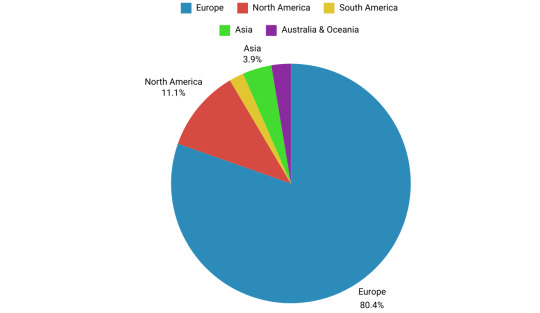
Just like last year, it’s no surprise that the majority of JOblr is European, with a total of 80.4%. The continents that follow are North America with 11.1%, Asia with 3.9%, Australia & Oceania with 2.6% and South America with 2%. We still haven’t gotten anyone from Africa.
Which country are you from?
Because it was optional, this question was answered by 130 respondents out of 153. Exciting things have happened since last year as we got 4 new countries in the ranking aaaand a new leader 👀
So let’s take a look at the top countries in JOblr 🥁…….
UK - 17
Finland - 16
Germany - 15
USA - 12
Poland - 9
Sweden - 5
Australia, France, Italy, Netherlands - 4
Croatia, Ireland, Russia, Spain - 3
Austria, Czechia, Denmark, Estonia, Romania - 2
Argentina, Belgium, Bolivia, Brazil, Canada, Greece, Hungary, India, Indonesia, Lithuania, Malta, Mexico, Nepal, Norway, Philippines, Portugal, Slovenia, Ukraine - 1
How old are you?

44.4% of the respondents are between 18-25 years old, followed by 20.3% between 26-30 years old. 18.3% are between 31-40 years old, 9.2% are under 18 while 3.9% are over 40.
Are you part of the LGBTQ+ community?
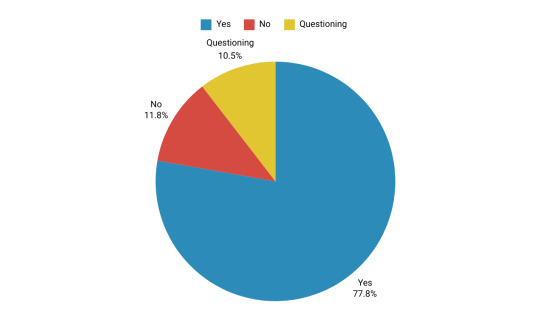
Unsurprising given the results last year, 77.8% of JOblr are part of the LGBTQ+ community, while 10.5% are questioning and 11.8% have answered no.
tumblr activity questions
When did you join JOblr?
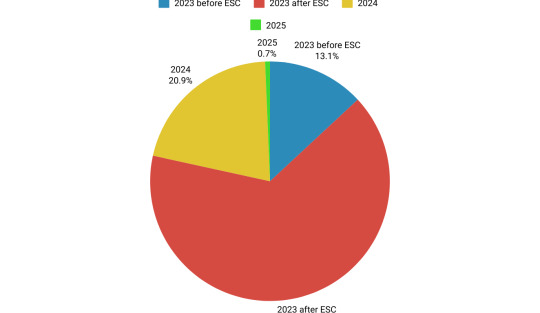
New question that I was very curious about. 65.4% of people joined JOblr after the Eurovision final, while 13.1% joined before it. 20.9% joined in 2024 while 1 person joined in 2025 (hello hello hope you enjoy your stay 👀!) No one joined before 2023.
How do you participate on JOblr?
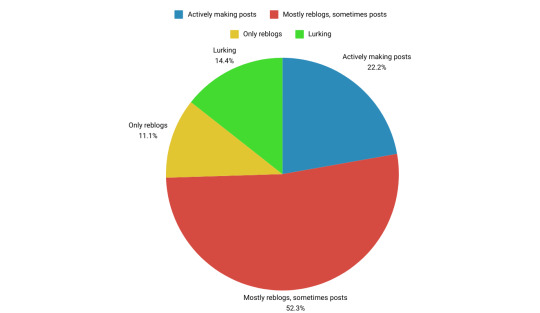
A majority of 80 people are mostly reblogging posts but sometimes making posts of their own, while 34 said to be active posters. We have a number of 22 lurkers and 17 who are only reblogging posts.
Do you post any of the following?

Another year full of incredible content created by this talented fandom!! 🫶 Written content like fanfiction and textposts seem to be the most posted.
What other fandoms beside Joker Out do you post about?
Another new question, where I wanted to see which other fandoms are the people here interested in. It was an optional question, some people giving a general answer or naming a specific fandom. Answers varied from musicians, shows & movies, books, sports, actors, characters, ships, video games, content creators, musicals and so on. Here I gathered all the specific fandoms that got more than one answer in order:
Musicians: Käärijä (23), Joost Klein (7), Blind Channel (5), Kuumaa (4), My Chemical Romance (3), Måneskin (2)
Shows/Movies: Arcane (6), Supernatural, Merlin (4), Tatort Saarbrücken (3), 9-1-1, Critical Role, Dead Boy Detectives, Good Omens, Gravity Falls, Hannibal, Hazbin Hotel/Helluva Boss, Julie and the Phantoms, Naruto, Star Trek (2)
Others: Eurovision (15), Hermitcraft, Life Series SMP (4), Dan and Phil, Formula 1, Sanremo (2)
joker out questions
How did you find out about Joker Out?

A big majority of 85.6% found out about Joker Out through Eurovision, as expected. Still, some of the respondents had different experiences as 9 respondents found out about them through Tumblr or other social media, 3 through a music platform and to 2 they were recommended by someone. Some respondents chose the “other” option and included:
finding out about JO through Käärijä
general slovenian knowledge
TikTok videos with Bojan
Who from the current members is your favorite?
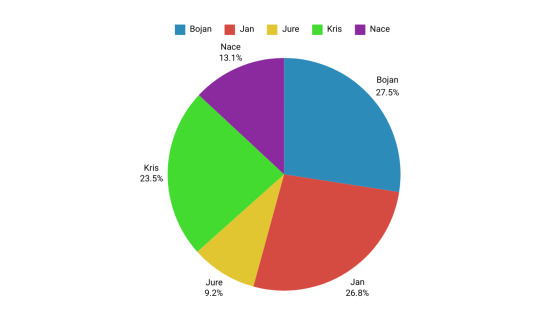
If last year the first place had a clear lead, this year there was a close battle. Therefore, here’s how JOblr’s top looks like:
Bojan - 42 votes
Jan - 41 votes
Kris - 36 votes
Nace - 20 votes
Jure - 14 votes
What's your favorite album?
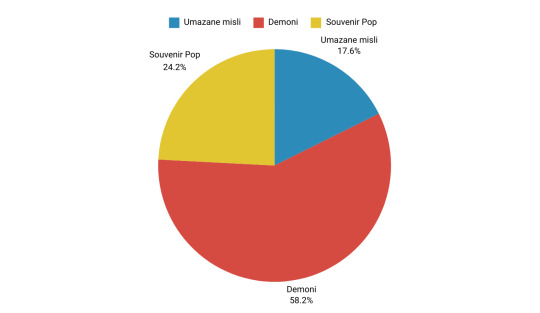
Given the release of the recent album, I decided to include this question as well. Here’s Tumblr’s top favorite Joker Out albums:
Demoni - 89 votes
Souvenir Pop - 37 votes
Umazane misli - 27 votes
Have you ever been to a Joker Out concert?
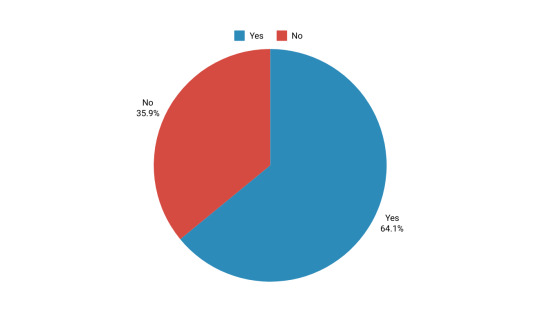
As opposed to last year where the result was more balanced, this time the concert goers have a clearer lead with 98 respondents having been to a Joker Out concert, while 55 haven’t.
For those who answered ”No” in the last year's survey, have you been to a Joker Out concert in the meantime?
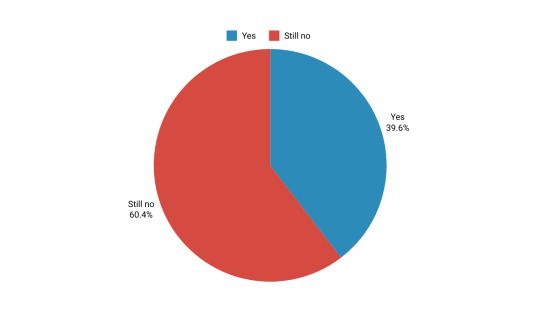
Out of the 99 who answered “No” in the previous survey, 48 answered to this question as followed: 19 have been to a Joker Out concert since last year’s survey, while 29 still haven’t.
If you're into RPF, which one of the most popular ships (according to AO3) is your favorite?
This was an optional question as well, where 135 out of 153 opted to respond to.
And oh my what a turn of events 👀 Let’s find out Tumblr’s top Joker Out ships:
🥁…..
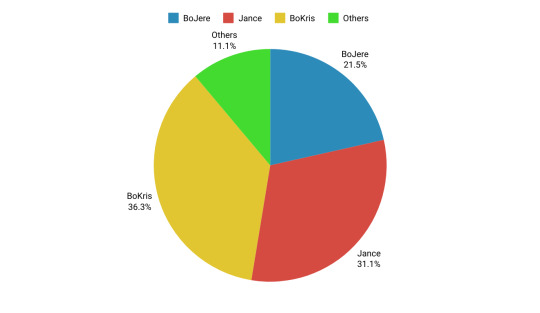
BoKris - 49 votes
Jance - 42 votes
BoJere - 29 votes
The “other” option was chosen as well and the following ships were included:
poly!JO
Bo(Jan)2
JanJure
KrisJure
BoNace
BoJance
NaceJere
You reached the end!! Thank you again for taking part in this, hope you all enjoyed and do tell me which were your favorite or the most surprising parts 💞💞 See you next year, perhaps (?)
#please excuse any grammar mistakes#joker out#bojan cvjetićanin#jan peteh#jure maček#kris guštin#nace jordan#joker out band#2025 results
102 notes
·
View notes
Text
2024 Book Review #72 – Alien Clay by Adrian Tchaikovsky

Tchaikovsky is not exactly one of my favourite working authors, but at this point he’s probably quite close. Certainly I haven’t yet regretted giving anything new of his I could get my hands on a try – and this is no exception (even if it’s not really that new, given I waited for my library system to get a copy). It doesn’t completely succeed at everything it goes for, but privileging themes over speculative xeno-biology is really a pretty fair choice, and as narratives go it was both fun and compelling.
The story follows Anton Daghdev – dissident, academic, and dissident academic who, for crimes against the Mandate of Humanity, has been sentenced to transportation to an extrasolar penal colony and a lifetime of hard labour furthering the Mandate’s understanding of the alien ecosystem which has flourished there. It’s a life sentence, make no mistake – but the fecund, symbiosis-obsessed ecology of ‘Kiln’ is far beyond anything he imagined when he was put into cryosleep for the 30 year voyage , and that’s before he is introduced to the real prize: Ruins. Real, artificial structures, with ornamentation, power generation, and writing – all signs of an intelligent creator which has entirely vanished from the ecosystem. Anton is caught between a camp that is itself is a horror show, ruled throgh brutality and fear by a commandant who devotion to the Mandate’s doctrines makes any actual understanding of Kiln impossible, and the ever-growing ecosystem beyond the compound’s walls that is forever seeking the right combination of proteins and molecules to form a bridge between species and worlds, ten thousand species of parasites and symbiotes forever seeking promising new hosts.
The book is concerned with several things, but the most obvious and the aesthetically dominant is the whole trope of the ‘death world’ – specifically the verdant and overgrowing jungle variety, where everything is green and beautiful and constantly looking for a way to kill you. A trope that’s always been more-or-less obviously inspired by 19th century European explorers and colonizers experience in the Amazon and Congo, and 20th century Americans in South East Asia – and the book is very interested in the colonial imagery, here. Everyone’s utter horror at the idea of contamination by the environment and its use as threat and punishment to keep the labourers in line is a central organizing principle of camp life. The fact that that the efforts to understand the nature of kilnish life and intelligence has been futile from the word go because of doctrines and assumptions the human scientists are labouring under and their studies has only ever been destructive and useless stamp-collecting is also just a theme running through the whole book.
From a slightly different perspective, this would be a fairly classic sci fi horror story, honestly – a moral atrocity of a scientific mission, destroyed in a fit of destructive karma as its prisoner/slave labour is infected and comes to know the alien life surrounding them in a way no human science could ever hope to. Very gothic, very Lovecraft. The lead archaeologist even gives a more-or-less sympathetic protagonist to tell it through.
As it is, on the level of genre this is basically an anti-cosmic horror story. The alien really is Alien, the world is vast and strange and you can’t really know anyone or anything – which is the trap. It’s not the alien infection that drives you mad, it’s the isolation and solitude of having felt the connection and ability to truly communicate without lies or deception it offers and then losing it beneath airlocks and thick plastic walls. It’s only be true trust and embrace of the most shockingly alien life ever seen – let alone any other humans – that the species can actually be liberated.
It rather reminds me of Last Exit by Max Gladstone that way – basically entirely different genres, but in both manage to make the alien seem truly terrifying and uncanny, and in both cases it’s the obsession with remaining pure and human and trying a sharp border between Us and Them that’s the real source of horror.
The thematic counterpoint here is the Mandate. It’s a totalitarian state in a very old-school, 20th century modernist way. Government through police spies and regular purges, legitimized by a grand historical project which is mostly just keeping everything neat and legible for the benefit of the top of the pyramid. It’s not that there aren’t true believers to the cause of Scientific Philanthropy, but it really doesn’t need that many of them. It rules through self-interest and fear – the tiny impossible hope of actually changing anything, or the absolute certainty of being sold out and swept up by the time your conspiracy has enough people in it to actually change anything. The Mandate makes it impossible to trust or rely upon anyone else, and by atomizing humanity makes it possible to bind them more tightly to the ruling state than ever before. It’s only be really radical – inhuman, really – levels of trust and cooperation and openness among people trying to resist that it can be fought, with its snitches and its tear gas and its automatic weaponry.
So yes, not the most subtle book in the world. But it definitely worked for me, on balance. It’s surprisingly rare to have a protagonist whose a committed political revolutionary on page 1 and never stops being one in damn near any story I come across, so maybe I just enjoyed the rare treat.
Though it does suffer some in the third act. An opinion I increasingly think I have about everything, but still. Kilnish xenobiology and -ecology is for the first two acts o the book is both aesthetically amazing and actually plausibly alien-seeming, but as Anton really understands it does become a bit credulity-stretchingly benevolent and purely symbiotic (not to mention structurally stable and only changing in the particulars across aeons), a few offhand lines about ‘red in two and claw’ aside. The narration also really doth protest too much about how the connection between the Kiln-infected humans totally isn’t telepathy. It wasn’t really a long book (certainly not by genre standards) but the whole final act also did just feel a bit bloated and meandering.
All of which is really just me being incapable of enjoying something without complaining though. If you like old-school feeling sci fi about alien worlds, Big Themes and improbably physically fit scientists, would recommend.
63 notes
·
View notes
Text
Happy Trans Day of Visibility!
Transgender Day of Visibility is recognized internationally each year on March 31st. Today, we celebrate the strength, joy, and resilience of transgender, Two-Spirit, non-binary and gender diverse people across the globe. Let’s continue to stand up, show support, and create a world of respect and equality for all– not just today, but every day!
As anti-trans legislation spreads and attacks on healthcare, sports, and basic rights increase, we must stand in solidarity with our trans siblings. If you’re itching to make a real difference for our trans community today (and honestly, every day), why not consider donating to some of these amazing organizations that are doing such vital work? Your generosity would be greatly appreciated!
Point of Pride focuses on helping vulnerable members of the queer community feel seen and have access to life-saving health and wellness programs and supports like their Annual Transgender Surgery Fund, their HRT Access Fund, Free Chest Binders + Free Femme Shapewear and more! They have awarded almost half a million dollars in direct financial assistance and donated thousands of gender-affirming garments to trans youth and adults in all 50 American states and around the world. Donate to Point of Pride here!
FOR THE GWORLS is a Black, trans-led collective that curates parties to fundraise money to help Black transgender people pay for their rent, gender affirming surgeries, smaller co-pays for medicine/doctor’s visits, and travel assistance. There’s two donation options for this collective: the rent assistance fund and the medical assistance fund. Take your pick~!
G.L.I.T.S is a Black, trans-led advocacy and direct services organization that is dedicated to fighting systemic discrimination against marginalized communities, in New York City and beyond. Founded in 2016, G.L.I.T.S addresses barriers faced by community members at the intersection of gender, race, and class through direct services, advocacy, mass mobilization, media engagement, and public education. Their initiatives include sustainable housing projects and plans for a dedicated health clinic, all documented as pilot projects for broader application– you can read all about their initiatives here and donate to them here!
El/La Para TransLatinas works towards a world where TransLatinas are protected, celebrated, and loved, where trans/intersex/gender diverse Latinx people are welcome, safe, represented and valued in all spheres of life. They envision a future in which the human rights to migration, housing, healthcare, food, and safety are respected and protected. For more than 30 years, El/La has been an advocate in the transgender community seeking justice for translatinas. They were THE first translatina HIV prevention program in Northern California. Donate to them here~!
TGEU (Trans Europe and Central Asia) is a trans-led nonprofit for the rights and wellbeing of trans people in Europe and Central Asia. TGEU was founded in 2005 under the name Transgender Europe e.V. Since then, they’ve established themselves as a legitimate voice for the trans community. In 2018, they expanded their regional scope to include Central Asia. TGEU now serves trans people in over 50 countries in Europe and Central Asia. TGEU envisions a world free from discrimination where gender diversity is celebrated, where trans people are valued, and where trans movements are self-aware, intersectional, and evolving to meet the needs of a diverse and resilient community. You can donate to them here.
Egale is a Canadian charity advocating for equal societies and systems free from homophobia, transphobia and all forms of oppression. Founded in 1986, the organization recently replaced “LGBTQ+” with the acronym “2SLGBTQI” in recognition of “Two Spirit” people. In 2023, Egale’s work included six research reports, 75 workplace inclusion trainings and 120+ resources in French and English. Egale envisions a Canada, and ultimately a world, without homophobia, biphobia, transphobia, and all other forms of oppression so that every person can achieve their full potential, free from hatred and bias. See their mission, values, history and more here and donate to Egale here!
36 notes
·
View notes
Text

An excerpt from a book of guidelines produced by the government of Tajikistan, showing women examples of what it deems proper attire to wear - as the nation looks to ban foreign, mainly Islamic, cultural influences and promote national "native" identity.
"Tajikistan's government passed a law banning the hijab, the latest in a string of 35 wide-ranging religion-related acts, in a move described by the government as "protecting national cultural values" and "preventing superstition and extremism".
The law, approved by parliament's upper house Majlisi Milli last Thursday, bans the use of "foreign clothing" — including the hijab, or head covering worn by Muslim women.
Instead, Tajikistan citizens are encouraged to wear Tajik national dress.
Those violating the law are set to be fined on a scale ranging from 7,920 Tajikistani somoni (almost €700) for ordinary citizens, 54,000 somoni (€4,694) for government officials and 57,600 somoni (about €5,000) if they are a religious figure.
Similar laws passed earlier this month affect several religious practices, such as the centuries-old tradition known in Tajikistan as "iydgardak," in which children go door-to-door to collect pocket money on Eid holidays.
The decision was seen as surprising, as the central Asian country of some 10 million is 96% Muslim, according to the last census in 2020.
Yet, it is a reflection of the political line that the government has been pursuing since 1997.
In Tajikistan, the government of president-for-life Emomali Rahmon has had its sights set on what they describe as extremism for a long time.
After a peace deal to end a five-year civil war in 1997, Rahmon — who has been in power since 1994 — first found a way to coexist with the opposition Tajikistan Islamic Resurrection Party (TIRP), which was granted a series of concessions.
According to the UN-brokered agreement, representatives of the pro-Sharia TIRP would share 30% of the government, and TIRP was recognised as the first post-Soviet political party in Central Asia founded on Islamic values.
However, Rahmon managed to push out TIRP from power despite the party becoming more secular over time. In 2015, he then managed to shut down TIRP altogether, designating it a terrorist organisation after the party allegedly took part in the failed coup attempt in which General Abdulhalim Nazarzoda, a key government bureaucrat, lost his life.
Meanwhile, he turned his attention to what his government described as "extremist" influences among the citizens.
After first banning the hijab in public institutions, including universities and government buildings, in 2009, the regime in Dushanbe pushed for a number of formal and informal rules meant to prevent neighbouring countries from exerting influence but also strengthen its control over the country.
While there are no legal restrictions on beards in Tajikistan, multiple reports state that law enforcement has forcibly shaved men sporting bushy beards, seen as a potential sign of someone's extremist religious views.
The Law on Parental Responsibility, which entered into force in 2011, penalises parents who send their children to religious education abroad, while according to the same law, those under 18 are banned from entering places of worship without permission.
A 2017 statement by the Tajikistan Religious Affairs Committee said that 1,938 mosques were closed down in just one year, and places of worship were converted into tea shops and medical centres, for example.
The latest set of laws was said to have been spurred by the deadly Crocus City Hall attack in Moscow in April. Four of the attackers captured by Russian law enforcement — said to be part of the Khorasan branch of the so-called Islamic State, or ISIS-K — had Tajikistan passports, according to Russian authorities.
President Rahmon, who said he aimed to make Tajikistan "democratic, sovereign, law-based and secular" — quoting the opening line of the 2016 Constitution — advised the people to "Love God with (their) heart".
"Do not forget your own culture," he stated.
The US Commission on International Religious Freedom (USCIRF) designated Tajikistan a "country of special concern" in its 2023 report."
40 notes
·
View notes